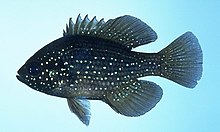Bluespotted sunfish
| Bluespotted sunfish | |
|---|---|

| |
| Scientific classification | |
| Domain: | Eukaryota |
| Kingdom: | Animalia |
| Phylum: | Chordata |
| Class: | Actinopterygii |
| Order: | Perciformes |
| Family: | Centrarchidae |
| Genus: | Enneacanthus |
| Species: | E. gloriosus
|
| Binomial name | |
| Enneacanthus gloriosus (Holbrook, 1855)
| |
| Synonyms[2] | |
| |
The bluespotted sunfish (Enneacanthus gloriosus) is a species of fish in the family Centrarchidae, the sunfishes. It is native to the southeastern and eastern United States, its distribution extending as far north as New Jersey, Pennsylvania, and far southern New York.[1][3] It is native throughout most of its range, but some populations represent introductions, such as those in Lake Ontario and the upper Susquehanna River system.[4]
In many areas, this fish is
Description
This fish reaches about 9.5 centimetres (3.7 in) in maximum length.[6] It is one of the smallest fish in its family.[7] It has spines in its dorsal and anal fins. Its tail fin is rounded in outline. Its body is covered in white or blue dots.[6] Some individuals have iridescent spots.[5] There may be a few pale bars on its sides,[6] but these are rare, especially in adults.[5]
A number of parasitic flatworms have been observed in this fish, such as Gyrodactylus gloriosi and several Urocleidus species.[8]
Habitat
Several aspects of the life history of the fish vary geographically. Fish on the East Coast and in
This freshwater fish occupies ponds, lakes, creeks, streams, and medium-sized rivers. It can tolerate slightly
This species is sometimes kept as an aquarium pet.[6][10]
Reproduction
The fish spawns several times in a season, sometimes daily for a long period of time.[9] The male builds a nest in the substrate or in plant matter.[1] Clutch sizes of 42 to 216 have been observed.[9]
Diet
The diet of the fish is rich in
References
- ^ . Retrieved 19 November 2021.
- ^ Froese, Rainer; Pauly, Daniel (eds.) (2019). "Enneacanthus gloriosus" in FishBase. December 2019 version.
- ^ a b "Enneacanthus gloriosus". NatureServe. Retrieved 24 May 2020.
- .
- ^ a b c Peterson, M. S. & S. T. Ross (1987). "Morphometric and meristic characteristics of a peripheral population of Enneacanthus" (PDF). Southeastern Fishes Council Proceedings. 17: 1–14.
- ^ a b c d e Fuller, P.; G. Jacobs; J. Larson; T.H. Makled & A. Fusaro (8 January 2020). "Enneacanthus gloriosus (Holbrook, 1855)". Nonindigenous Aquatic Species Database, Gainesville, FL. U.S. Geological Survey. Retrieved 24 May 2020.
- .
- PMID 4699870.
- ^ S2CID 86258004.
- ^ a b Kraft, C.E.; D.M. Carlson; M. Carlson (2006). "Bluespotted Sunfish (Enneacanthus gloriosus)". Inland Fishes of New York (Online). Version 4.0. Department of Natural Resources, Cornell University, and the New York State Department of Environmental Conservation.
- ^ Kern, W. H. (2004). "Some small native freshwater fish recommended for mosquito and midge control in ornamental ponds". University of Florida IFAS Extension Fact Sheet ENY-670.

